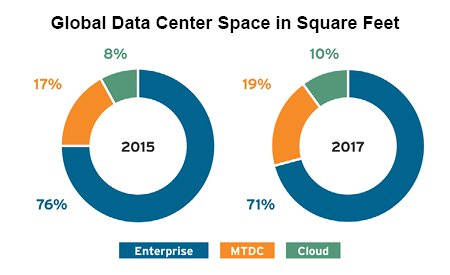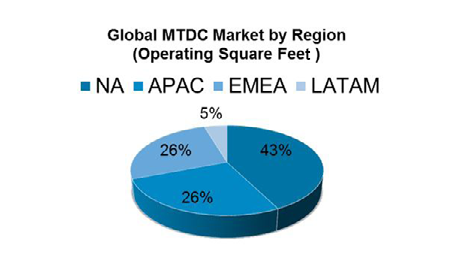Know Your Options: MTDCs and the Cloud
With the costs and hassles of building and owning an onsite data center infrastructure increasing, enterprise data centers pose serious headaches to IT managers – especially when it comes to expanding and upgrading existing data centers to support emerging technology. For this reason, the advantages of utilizing other options – public cloud, private cloud, hybrid cloud and/or multi-tenant data centers (MTDCs) – are becoming obvious to many.
Working with the Cloud
Cloud adoption is rapidly expanding in the enterprise. Gartner projects that the public cloud service market, including BPaaS (business process as a service), SaaS (software as a service), PaaS (platform as a service), IaaS (infrastructure as a service), security and advertising will grow by 16.5% to reach $204 billion this year. By lowering cloud pricing to a very attractive level, cloud suppliers such as AWS, Microsoft Azure and Google suggest that companies should consider putting all of their IT in the cloud.

Many organizations have deployed a hybrid cloud solution to leverage the benefits of on-premises and off-premises IT infrastructures by deploying workloads across multiple cloud platforms. This multi-cloud strategy could optimize the physical location and execution of each task and ensure the highest level of information security. It mixes on-premises, private cloud and third-party/public cloud services, with links between the platforms. Essentially, the infrastructure consists of a private cloud and at least one cloud managed by a third party.
Consider MTDCs as an Option
In many situations, onsite data centers and cloud data centers – or a mix of the two – can’t yet satisfy the needs of the majority of organizations. The amount of data to be stored, along with the amount of physical servers, continues to grow – as do space, security, reliability and IT staff expertise requirements.

MTDC service providers can offer IT professionals a relatively minimal upfront investment associated with new IT capacity deployment while reducing short-term capital expenditures and long-term operating expenditures. They lease data center space, connectivity options, power and security to other businesses, which then purchase and bring in their own servers.
The market is experiencing rapid growth, with 12.1% CAGR (compound annual growth rate) and $23 billion in revenue last year. Today, there are more than 1,000 MTDC companies, and more than 4,600 global MTDC sites. Total MTDC space will grow from 110 million square feet (as of 2015) to 150 million square feet in 2017.

The physical footprint of MTDCs can be even larger than CSP (cloud service provider) data centers. According to 451 Research, of the top 40 data centers measured in square feet:
- 25 are MTDCs
- 12 are hyper-scale CSP data centers
- 3 are government data centers
What Do MTDCs Host?
While many internet service providers (ISPs), such as NTT, Verizon and China Telecom, own and lease their IT infrastructure, the MTDC companies specializing in colocation and hosting, such as DuPont Fabros, Equinix, Digital Realty, QTS, RagingWire and Sabey, offer efficient and agile service types and features to suit different customer bases. They can provide cross-connects to different ISPs and direct-access CSPs. Enterprise customers can benefit from direct network service for different business requirements with pay-as-you-go strategies that have no long-term commitment.
The service providers also host CSPs, such as AWS and Microsoft, and content delivery networks (CDNs) such as YouTube and Netflix. Excellent wide-area connectivity at the edge is the key to success for cloud computing and cloud storage; they are distributed and local to extend cloud coverage much closer to end-users.
In this new cloud ecosystem, MTDCs can leverage efficiencies of scale from the broad customer base to achieve a more competitive cost structure for space, power and network infrastructure than most single-tenant data centers could attain. They also have immense buying power to negotiate the price with major data center infrastructure suppliers, benefitting from the same advantages as hyperscale CSP data centers (such as Open Compute projects).
Better Services from MTDCs
As the market undergoes consolidation, with many recent mergers and acquisitions (Digital Realty acquired Telx, Equinix merged with Telecity, etc.), the effect will become even more obvious. As a result of competition, MTDCs will be able to offer better services with lower costs to enterprise customers and CSPs, although, as of today, servers are still purchased independently by customers.
Are you searching for an alternative to your enterprise data center? Belden can help you determine whether public cloud, private cloud, hybrid cloud and/or MTDCs are right for your organization and business needs. Contact us today!

![System.String[]](https://assets.belden.com/transform/d88d257f-c23d-4a61-b354-d49d9932ec65/qing-xu?io=transform:fill,width:300,height:300)